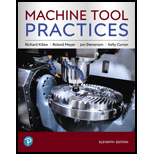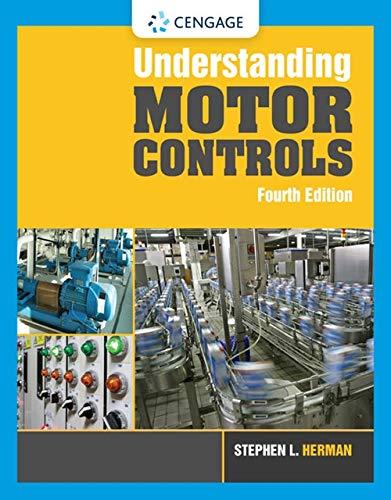
Machine Tool Practices (11th Edition)
11th Edition
ISBN: 9780134893501
Author: Richard R. Kibbe, Roland O. Meyer, Jon Stenerson, Kelly Curran
Publisher: PEARSON
expand_more
expand_more
format_list_bulleted
Textbook Question
Chapter B.3, Problem 1ST
What is the kerf?
Expert Solution & Answer
Want to see the full answer?
Check out a sample textbook solution
Students have asked these similar questions
B/40 The body is constructed of a uniform square plate, a uniform straight rod, a uniform quarter‐circular rod, and a particle (negligible dimensions). If each part has the indicated mass, determine the mass moments of inertia of the body about the x‐, y‐, and z‐axes. Answer Given.
(read image) Answer:
(read image) Answer Given
Chapter B Solutions
Machine Tool Practices (11th Edition)
Ch. B.1 - List several uses of the arbor press.Ch. B.1 - A newly machined steel shaft with an interference...Ch. B.1 - The ram of an arbor press is loose in its guide...Ch. B.1 - When a bushing is pushed into a bore that is...Ch. B.1 - Prob. 5STCh. B.1 - What difference is there in the way a press fit is...Ch. B.1 - Prior to installing a bushing with the arbor...Ch. B.1 - Name five ways to avoid tool breakage and other...Ch. B.2 - Name two types of bench visesCh. B.2 - Prob. 2ST
Ch. B.2 - How can the finished surface of a part be...Ch. B.2 - Name three things that should never be done to a...Ch. B.2 - How should a vise be Lubricated?Ch. B.2 - Prob. 6STCh. B.2 - What advantage does the lever-jawed wrench offer...Ch. B.2 - Some objects should never be struck with a hard...Ch. B.2 - Why should pipe wrenches never be used on bolts,...Ch. B.2 - What are the two important things to remember...Ch. B.3 - What is the kerf?Ch. B.3 - What is the set on a saw blade?Ch. B.3 - What is the pitch of the hacksaw blade?Ch. B.3 - What determines the selection of a saw blade for a...Ch. B.3 - Hand hacksaw blades fall into two basic...Ch. B.3 - Give four causes that make saw blades dull.Ch. B.3 - Give two reasons why hacksaw blades break.Ch. B.3 - A new hacksaw blade should not be used in a cut...Ch. B.4 - What are the four different cuts found on files?Ch. B.4 - Name four coarseness designations for files.Ch. B.4 - Which of the two kinds of files-single cut or...Ch. B.4 - What are the coarseness designations for needle...Ch. B.4 - Prob. 5STCh. B.4 - What causes a file to get dull?Ch. B.4 - Why should a handle be used on a file?Ch. B.4 - How does the hardness of a workpiece affect the...Ch. B.4 - Should pressure be applied to a file on the return...Ch. B.4 - Why is a round file rotated while it is being...Ch. B.5 - Prob. 1STCh. B.5 - What is the purpose of a starting taper on a...Ch. B.5 - What is the advantage of a spiral flute reamer...Ch. B.5 - How does the shank diameter of a hand reamer...Ch. B.5 - Prob. 5STCh. B.5 - Prob. 6STCh. B.5 - What is the purpose of cutting fluid in reaming?Ch. B.5 - Prob. 8STCh. B.5 - How much reaming allowance is left for hand...Ch. B.5 - If you were repairing the lathe tailstock taper,...Ch. B.6 - What type of tap is used to produce threads that...Ch. B.6 - Prob. 2STCh. B.6 - Prob. 3STCh. B.6 - When is a spiral fluted tap used?Ch. B.6 - How are thread-forming taps different from...Ch. B.6 - How are taper pipe taps identified?Ch. B.6 - Why are finishing and roughing Acme taps used?Ch. B.6 - Why are rake angles varied on taps for different...Ch. B.7 - What kind of tools are used to drive taps when...Ch. B.7 - What is a hand tapper?Ch. B.7 - What is a tapping attachment?Ch. B.7 - Which three factors affect the strength of a...Ch. B.7 - How deep should the usable threads be in a tapped...Ch. B.7 - What causes taps to break while tapping?Ch. B.7 - What causes rough and tom threads?Ch. B.7 - Give three methods of removing broken taps from...Ch. B.8 - What is a die?Ch. B.8 - What tool is used to drive a die?Ch. B.8 - How much adjustment is possible with a round split...Ch. B.8 - What are important points to watch when assembling...Ch. B.8 - Why do dies have a chamfer on the cutting end?Ch. B.8 - Why are cutting fluids used?Ch. B.8 - What diameter should a rod be before being...Ch. B.8 - Why should a rod be chamfered before being...Ch. B.9 - Prob. 1STCh. B.9 - Why should a tool grinder never be used for rough...Ch. B.9 - Prob. 3STCh. B.9 - Prob. 4STCh. B.9 - Prob. 5STCh. B.9 - Prob. 6STCh. B.9 - Prob. 7STCh. B.9 - What is the purpose of the wheel blotter?Ch. B.9 - Prob. 9STCh. B.9 - What does the wheel ring test do?
Knowledge Booster
Learn more about
Need a deep-dive on the concept behind this application? Look no further. Learn more about this topic, mechanical-engineering and related others by exploring similar questions and additional content below.Similar questions
- B/16. The plane area shown in the top portion of the figure is rotated 180° about the x‐axis to form the body of revolution of mass m shown in the lower portion of the figure. Determine the mass moment of inertia of the body about the x‐axis. Answer Givenarrow_forward(read image) Answer:arrow_forward(read image) Answer:arrow_forward
- 2nd Law of Thermodynamics A 1.5-ft3 rigid tank contains saturated refrigerant-134 at 170 psia. Initially, 20 percent of the volume isoccupied by liquid and the rest by vapor. A valve at the top of the tank is now opened, and vapor is allowedto escape slowly from the tank. Heat is transferred to the refrigerant such that the pressure inside the tankremains constant. The valve is closed when the last drop of liquid in the tank is vaporized. Determine thetotal heat transfer for this process.arrow_forwardDraw the shear and bending-moment diagrams for the beam and loading shown, and determine the maximum normal stress due to bending. 4.8 kips/ft 32 kips B C D E I Hinge 8 ft. 2 ft 5 ft 5 ft W12 x 40arrow_forward2nd Law of Thermodynamics A rigid, insulated tank that is initially evacuated is connected through a valve to the supply line that carrieshelium at 300 kPa and 140◦C. Now the valve is opened, and helium is allowed to flow into the tank until thepressure reaches 300 kPa, at which point the valve is closed. Determine the flow work of the helium in thesupply line and the final temperature of the helium in the tank.arrow_forward
- Draw the shear and bending-moment diagrams for the beam and loading shown, and determine the maximum normal stress due to bending. 5 kips 10 kips B I W14 x 22 -5 ft -8 ft 5 ft-arrow_forward2nd Law of Thermodynamics Liquid water at 200 kPa and 25◦C is heated in a chamber by mixing it with superheated steam at 200 kPaand 250◦C. cold water enters the chamber at a rate of 2 kg/s. If the mixture leaves the mixing chamber at50◦C, determine the mass flow rate of the superheated steam required.arrow_forwardThe 2nd Law of Thermodynamics Refrigerant-134a enters the compressor of a refrigeration system as saturated vapor at 0.16 MPa, and leavesas superheated vapor at 0.9 MPa and 70◦C at a rate of 0.08 kg/s. Determine the rates of energy transfers bymass into and out of the compressor. Assume the kinetic and potential energies are negligible.arrow_forward
- 2nd Law of Thermodynamics Water enters the tubes of a cold plate at 65◦C with an average velocity of 50 ft/min and leaves at 110◦F. Thediameter of the tubes is 0.2 in. Assuming 20 percent of the heat generated is dissipated from the componentsto the surroundings by convection and radiation, and the remaining 80 percent is removed by the coolingwater, determine the amount of heat generated by the electronic devices mounted on the cold plate.arrow_forwardThe 2nd Law of Thermodynamics Refrigerant-134a enters a diffuser steadily as saturated vapor 500 kPa with a velocity of 170 m/s, and it leavesat 600 kPa and 50◦C. the refrigerant is gaining heat at a rate of 2.5 kJ/s as it passes through the diffuser. Ifthe exit area is 75 percent greater than the inlet area, determine (a) the exit velocity (b) the mass flow rate of the refrigerant.arrow_forward2nd Law of Thermodynamics Refrigerant-134a is throttled from the saturated liquid state at 850 kPa to a pressure of 200 kPa. Determinethe temperature drop during this process and the final specific volume of the refrigerant.arrow_forward
arrow_back_ios
SEE MORE QUESTIONS
arrow_forward_ios
Recommended textbooks for you
 Welding: Principles and Applications (MindTap Cou...Mechanical EngineeringISBN:9781305494695Author:Larry JeffusPublisher:Cengage Learning
Welding: Principles and Applications (MindTap Cou...Mechanical EngineeringISBN:9781305494695Author:Larry JeffusPublisher:Cengage Learning Refrigeration and Air Conditioning Technology (Mi...Mechanical EngineeringISBN:9781305578296Author:John Tomczyk, Eugene Silberstein, Bill Whitman, Bill JohnsonPublisher:Cengage Learning
Refrigeration and Air Conditioning Technology (Mi...Mechanical EngineeringISBN:9781305578296Author:John Tomczyk, Eugene Silberstein, Bill Whitman, Bill JohnsonPublisher:Cengage Learning Precision Machining Technology (MindTap Course Li...Mechanical EngineeringISBN:9781285444543Author:Peter J. Hoffman, Eric S. Hopewell, Brian JanesPublisher:Cengage Learning
Precision Machining Technology (MindTap Course Li...Mechanical EngineeringISBN:9781285444543Author:Peter J. Hoffman, Eric S. Hopewell, Brian JanesPublisher:Cengage Learning Understanding Motor ControlsMechanical EngineeringISBN:9781337798686Author:Stephen L. HermanPublisher:Delmar Cengage Learning
Understanding Motor ControlsMechanical EngineeringISBN:9781337798686Author:Stephen L. HermanPublisher:Delmar Cengage Learning

Welding: Principles and Applications (MindTap Cou...
Mechanical Engineering
ISBN:9781305494695
Author:Larry Jeffus
Publisher:Cengage Learning

Refrigeration and Air Conditioning Technology (Mi...
Mechanical Engineering
ISBN:9781305578296
Author:John Tomczyk, Eugene Silberstein, Bill Whitman, Bill Johnson
Publisher:Cengage Learning

Precision Machining Technology (MindTap Course Li...
Mechanical Engineering
ISBN:9781285444543
Author:Peter J. Hoffman, Eric S. Hopewell, Brian Janes
Publisher:Cengage Learning

Understanding Motor Controls
Mechanical Engineering
ISBN:9781337798686
Author:Stephen L. Herman
Publisher:Delmar Cengage Learning
Physics 33 - Fluid Statics (1 of 10) Pressure in a Fluid; Author: Michel van Biezen;https://www.youtube.com/watch?v=mzjlAla3H1Q;License: Standard YouTube License, CC-BY